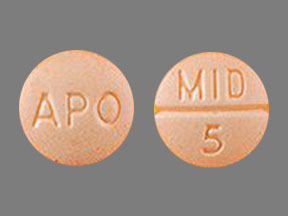Midodrine Side Effects
Medically reviewed by Drugs.com. Last updated on Oct 26, 2023.
Applies to midodrine: oral tablet.
Warning
Oral route (Tablet)
Can cause marked elevation of supine blood pressure and should be used only in patients whose lives are considerably impaired despite standard clinical care. Clinical benefits of midodrine hydrochloride tablets, principally improved ability to carry out activities of daily living, have not been verified.
Serious side effects of Midodrine
Along with its needed effects, midodrine may cause some unwanted effects. Although not all of these side effects may occur, if they do occur they may need medical attention.
Check with your doctor immediately if any of the following side effects occur while taking midodrine:
More common
- Blurred vision
- cardiac awareness
- headache
- pounding in the ears
Rare
- Fainting
- increased dizziness
- slow pulse
Other side effects of Midodrine
Some side effects of midodrine may occur that usually do not need medical attention. These side effects may go away during treatment as your body adjusts to the medicine. Also, your health care professional may be able to tell you about ways to prevent or reduce some of these side effects.
Check with your health care professional if any of the following side effects continue or are bothersome or if you have any questions about them:
More common
- Burning, itching, or prickling of the scalp
- chills
- goosebumps
- urinary frequency, retention, or urgency
Less common
- Anxiety or nervousness
- confusion
- dry mouth
- flushing
- headache or feeling of pressure in the head
- skin rash
Rare
- Backache
- canker sores
- dizziness
- drowsiness
- dry skin
- leg cramps
- pain or sensitivity of the skin to touch
- stomach problems such as gas, heartburn, or nausea
- trouble seeing
- trouble with sleeping
- weakness
For Healthcare Professionals
Applies to midodrine: oral tablet.
General
The most common adverse reactions were paresthesia (includes hyperesthesia and scalp paresthesia), piloerection, dysuria (includes dysuria, increased urinary frequency, impaired urination, urinary retention, and urinary urgency), pruritus (includes scalp pruritus), and supine hypertension.[Ref]
Cardiovascular
Common (1% to 10%): Supine hypertension, flushing
Uncommon (0.1% to 1%): Reflex bradycardia
Rare (less than 0.1%): Tachycardia, palpitations
Frequency not reported: Vasodilation/flushing face[Ref]
Nervous system
Very common (10% or more): Paresthesia (18.3%)
Common (1% to 10%): Headache
Frequency not reported: Feeling of pressure/fullness in the head, dizziness, somnolence[Ref]
Dermatologic
Very common (10% or more): Piloerection (13.4%), pruritus (12.2%)
Common (1% to 10%): Rash
Frequency not reported: Skin hyperesthesia, erythema multiforme, dry skin[Ref]
Genitourinary
Very common (10% or more): Dysuria (13.4%)
Frequency not reported: Impaired urination[Ref]
Gastrointestinal
Common (1% to 10%): Nausea, dyspepsia, stomatitis
Frequency not reported: Dry mouth, canker sore, pyrosis, gastrointestinal distress, flatulence, abdominal pain, vomiting, diarrhea[Ref]
Other
Common (1% to 10%): Chills, pain
Frequency not reported: Asthenia[Ref]
Psychiatric
Uncommon (0.1% to 1%): Sleep disorders, insomnia, restlessness, excitability, irritability
Frequency not reported: Confusion/thinking abnormality, nervousness/anxiety[Ref]
Hepatic
Rare (less than 0.1%): Abnormal hepatic function, raised liver enzymes[Ref]
Musculoskeletal
Frequency not reported: Backache, leg cramps[Ref]
Ocular
Frequency not reported: Visual field defect[Ref]
More about midodrine
- Check interactions
- Compare alternatives
- Pricing & coupons
- Reviews (45)
- Drug images
- Dosage information
- During pregnancy
- Drug class: miscellaneous cardiovascular agents
- En español
Patient resources
Other brands
Professional resources
Other brands
Related treatment guides
References
1. Product Information. ProAmatine (midodrine). Roberts Pharmaceutical Corporation. 2001;PROD.
2. Cerner Multum, Inc. UK Summary of Product Characteristics.
Further information
Always consult your healthcare provider to ensure the information displayed on this page applies to your personal circumstances.
Some side effects may not be reported. You may report them to the FDA.

